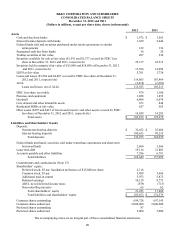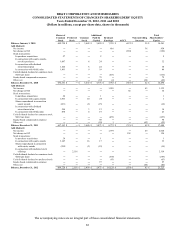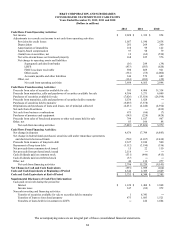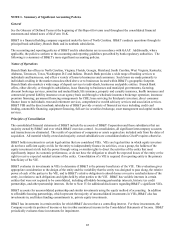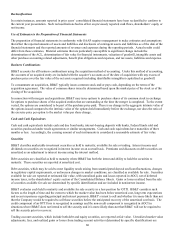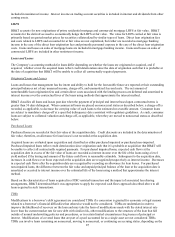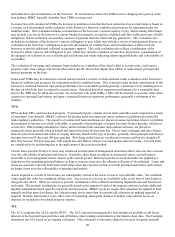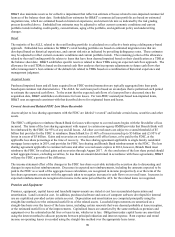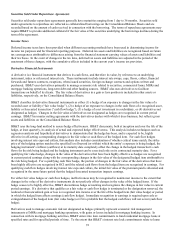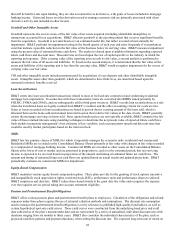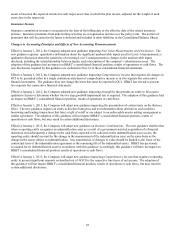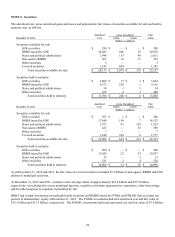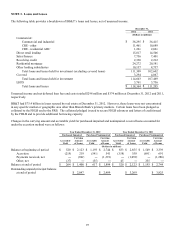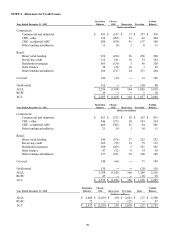BB&T 2012 Annual Report Download - page 112
Download and view the complete annual report
Please find page 112 of the 2012 BB&T annual report below. You can navigate through the pages in the report by either clicking on the pages listed below, or by using the keyword search tool below to find specific information within the annual report.
90
BB&T also maintains reserves for collective impairment that reflect an estimate of losses related to non-impaired commercial
loans as of the balance sheet date. Embedded loss estimates for BB&T’ s commercial loan portfolio are based on estimated
migration rates, which are estimated based on historical experience, and current risk mix as indicated by the risk grading
process described above. Embedded loss estimates may be adjusted to reflect current economic conditions and current
portfolio trends including credit quality, concentrations, aging of the portfolio, and significant policy and underwriting
changes.
Retail
The majority of the ALLL related to the retail lending portfolio is calculated on a collective basis using a delinquency-based
approach. Embedded loss estimates for BB&T’ s retail lending portfolio are based on estimated migration rates that are
developed based on historical experience, and current risk mix as indicated by prevailing delinquency rates. These estimates
may be adjusted to reflect current economic conditions and current portfolio trends. The remaining portion of the allowance
related to the retail lending portfolio relates to loans that have been deemed impaired based on their classification as a TDR at
the balance sheet date. BB&T establishes specific reserves related to these TDRs using an expected cash flow approach. The
allowance for retail TDRs is based on discounted cash flow analyses that incorporate adjustments to future cash flows that
reflect management’ s best estimate of the default risk related to TDRs based on a combination of historical experience and
management judgment.
Acquired Loans
Purchased impaired loans and all loans acquired in an FDIC-assisted transaction are typically aggregated into loan pools
based upon common risk characteristics. The ALLL for each loan pool is based on an analysis that is performed each period
to estimate the expected cash flows. To the extent that the expected cash flows of a loan pool have decreased since the
acquisition date, BB&T establishes an allowance for loan losses. For non-FDIC assisted purchased non-impaired loans,
BB&T uses an approach consistent with that described above for originated loans and leases.
Covered Assets and Related FDIC Loss Share Receivable
Assets subject to loss sharing agreements with the FDIC are labeled “covered” and include certain loans, securities and other
assets.
The FDIC’ s obligation to reimburse Branch Bank for losses with respect to covered assets begins with the first dollar of loss
incurred. The terms of the loss sharing agreement with respect to certain non-agency RMBS provides that Branch Bank will
be reimbursed by the FDIC for 95% of any and all losses. All other covered assets are subject to a stated threshold of $5
billion that provides for the FDIC to reimburse Branch Bank for (1) 80% of losses incurred up to $5 billion and (2) 95% of
losses in excess of $5 billion. Gains and recoveries on covered assets will offset losses, or be paid to the FDIC, at the
applicable loss share percentage at the time of recovery. The loss sharing agreement applicable to single family residential
mortgage loans expires in 2019, and provides for FDIC loss sharing and Branch Bank reimbursement to the FDIC. The loss
sharing agreement applicable to commercial loans and other covered assets expires in 2014, however, Branch Bank must
reimburse the FDIC for realized gains and recoveries through August 2017. At the conclusion of the loss share period should
actual aggregate losses, excluding securities, be less than an amount determined in accordance with these agreements, BB&T
will pay the FDIC a portion of the difference.
The income statement effect of the changes in the FDIC loss share receivable includes the accretion due to discounting and
changes in expected net reimbursements. Decreases in expected net reimbursements, including the amounts expected to be
paid to the FDIC as a result of the aggregate losses calculation, are recognized in income prospectively over the term of the
loss share agreements consistent with the approach taken to recognize increases in cash flows on covered loans. Increases in
expected reimbursements are recognized in income in the same period that the ACL for the related loans is recognized.
Premises and Equipment
Premises, equipment, capital leases and leasehold improvements are stated at cost less accumulated depreciation and
amortization. Land is stated at cost. In addition, purchased software and costs of computer software developed for internal
use are capitalized provided certain criteria are met. Depreciation and amortization are computed principally using the
straight-line method over the estimated useful lives of the related assets. Leasehold improvements are amortized on a
straight-line basis over the lesser of the lease terms, including certain renewals that were deemed probable at lease inception,
or the estimated useful lives of the improvements. Capitalized leases are amortized by the same methods as premises and
equipment over the estimated useful lives or lease terms, whichever is less. Obligations under capital leases are amortized
using the interest method to allocate payments between principal reduction and interest expense. Rent expense and rental
income on operating leases is recorded using the straight-line method over the appropriate lease terms.


